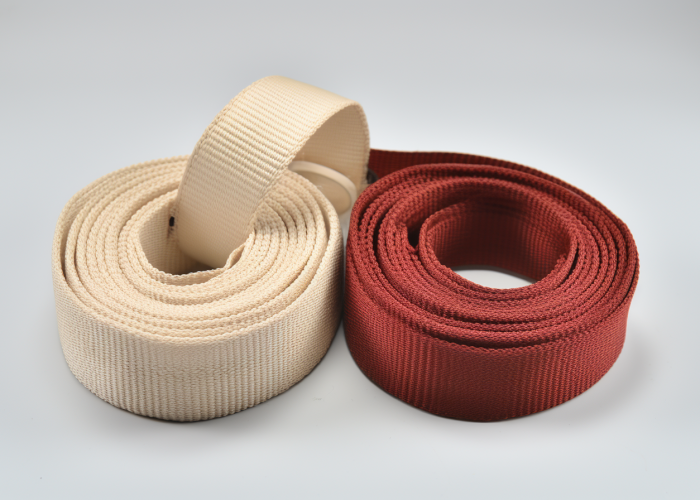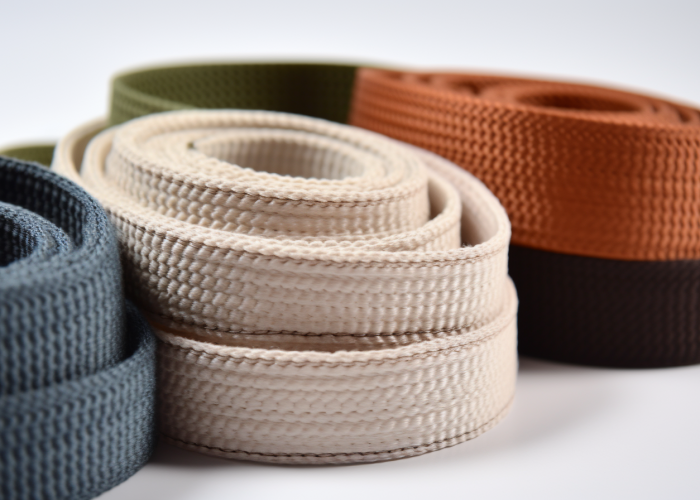Heavy-duty applications demand webbing materials that can withstand extreme loads and environmental stress. Cotton webbing often appears as a cost-effective option, but understanding its true capabilities is essential for safe product design. At Anmyda, we help product developers navigate material selection challenges through engineering consultation and custom webbing solutions.
No, cotton webbing is unsuitable for heavy-duty tasks. It offers only 150–250 lbs/inch tensile strength—far below the 4,500–10,000+ lbs/inch of synthetic alternatives—and loses 30–40% strength after 50 load cycles. Its moisture absorption further reduces performance by 15–20%, making it unreliable for lifting, fall protection, or safety-critical uses.
Discover why cotton webbing underperforms in demanding uses, what regulations limit it, and explore stronger, cost-effective alternatives for your application.


Webbing manufacturing expert with 15+ years of experience helping product developers build high-performance straps for industrial, medical, and outdoor use.
Cotton webbing offers 150–250 lbs/inch tensile strength—18–67 times weaker than nylon or polyester. Matching synthetic load capacity would require 6–30 times more material, leading to excessive bulk and weight. This makes cotton impractical and unsafe for heavy-duty applications.
Key Points at a Glance:
The strength gap creates cascading design problems in real applications. In practice, projects initially attracted to cotton’s lower per-yard price typically switch once engineers calculate total system costs including oversized hardware, assembly time, and shipping weights. Achieving 5,000 pounds of breaking strength requires 20-33 inches of cotton webbing compared to 1-2 inches of nylon, making connection points, storage, and handling impractical.
Cotton’s sudden failure mode does not meet safety standards for heavy-duty use. Unlike synthetics that stretch 5-15% and provide visual warning, cotton snaps without indication at maximum load. This fails to comply with OSHA 1926.502 fall protection requirements and ANSI Z359.1 energy-absorbing standards, which mandate synthetic materials for safety-critical applications. Cotton also loses 30-40% strength after 50 dynamic fatigue load cycles versus nylon’s minimal degradation under repeated stress.
Engineering consultation helps identify these limitations before costly product failures occur. Industry standards like MIL-W-4088K specifically require nylon for military load-bearing applications, while ASTM D6775 testing protocols reveal cotton’s inability to maintain performance under environmental stress conditions. Custom hybrid solutions can incorporate synthetic reinforcement threads to address strength gaps while maintaining cotton’s comfort, appearance, or hypoallergenic properties for specific applications.
Yes, weather heavily impacts cotton webbing. Moisture absorption cuts strength by 15–20% at 65% humidity, and UV exposure causes up to 41% annual strength loss—far higher than nylon’s 7%. Cotton also becomes brittle in freezing conditions and loses integrity above 400°F, retaining only 60–70% strength in humid environments.
Key Points at a Glance:
Moisture absorption creates the most significant performance impact. Cotton naturally absorbs 8-25% of its weight in moisture at typical outdoor humidity levels (65% RH), directly reducing tensile strength by 15-20%. This means load capacity varies with weather conditions, making cotton unreliable for consistent performance. Prolonged dampness promotes mildew growth that weakens cellulose fibers, creating progressive strength loss over time.
UV radiation accelerates cotton degradation far exceeding synthetic alternatives. ASTM G155 accelerated weathering testing shows cotton loses 41% of original strength annually from solar radiation, compared to nylon’s minimal 7% loss. Temperature extremes compound these effects, with cotton becoming brittle below 0°C and losing structural integrity well before its 400°F charring point.
ASTM D6775 testing protocols reveal strength variations of 30-40% between optimal and adverse conditions, making engineering calculations unreliable for outdoor applications. Custom solutions can incorporate synthetic core reinforcement or protective coatings to mitigate environmental effects while maintaining cotton’s aesthetic characteristics.
Cotton webbing fails in industrial use because it lacks the tensile strength, fatigue resistance, and environmental durability required for heavy loads, repeated stress, and harsh conditions. It degrades quickly from shock loads, abrasion, moisture, UV exposure, and chemicals—making it unreliable for applications demanding high safety and performance.
Key Points at a Glance:
Shock load vulnerability represents cotton’s most dangerous failure mode. Unlike nylon’s 5-15% elastic elongation that absorbs energy and provides visual warning before failure, cotton’s rigid structure transfers full impact forces directly to connection points. This lack of elongation means operators receive no visual feedback of approaching failure limits, causing catastrophic snapping without warning in crane rigging or fall arrest applications.
Abrasion and chemical exposure accelerate deterioration. ASTM D3884 Martindale testing reveals cotton fails after 300-500 friction cycles compared to nylon’s 1,200-1,500 cycles. Industrial chemical exposure compounds this vulnerability, with cotton degrading rapidly in acidic or alkaline conditions common in manufacturing. Cotton also experiences 30-40% strength loss after 50 dynamic load cycles versus synthetic’s <5% loss.
Connection point failures create additional safety risks. Cotton experiences 40-60% strength reduction at knots and hardware connections compared to nylon’s 25% reduction. OSHA incident reports frequently cite cotton webbing failures in industrial environments where synthetic alternatives maintain performance and provide predictable failure characteristics.

No, cotton webbing is not OSHA approved for heavy-duty use. OSHA 1926.502 prohibits natural fibers in personal fall arrest systems, requiring synthetic materials instead. Standards like ANSI Z359.1 and MIL-W-4088K also mandate synthetic webbing for load-bearing and safety-critical applications due to its superior strength, durability, and reliability.
Key Points at a Glance:
OSHA regulations specifically exclude cotton from safety-critical applications due to its inability to meet dynamic loading requirements. OSHA 1926.502 mandates that fall arrest systems limit maximum forces to 1800 pounds, which cotton cannot achieve due to its lack of energy-absorbing stretch (5-15% elongation required). Cotton harnesses transfer full fall forces directly to users without controlled deceleration, creating arrest forces exceeding 4000-5000 pounds.
Industry standards reinforce OSHA’s position with specific synthetic requirements. ANSI Z359.1 requires energy-absorbing lanyards with controlled elongation capability, while MIL-W-4088K mandates nylon for military applications. ASTM D6775 testing demonstrates cotton’s inability to meet these performance requirements under dynamic loading.
Safety factor calculations for fall protection require 5:1 margins that cotton cannot provide, making synthetic alternatives mandatory for compliance. Custom webbing solutions can incorporate OSHA-compliant synthetic materials while addressing specific requirements through specialized construction techniques that maintain regulatory approval.
Use cotton webbing in low-stress applications where comfort, breathability, or hypoallergenic properties matter more than strength—such as bag straps, apparel trim, medical braces, and eco-friendly packaging. It’s ideal for static loads under 100 lbs in controlled environments where natural fibers are preferred over synthetics.
Property Cotton Webbing Nylon Webbing Polyester Webbing
Tensile Strength 150–250 lbs/inch 4,500–10,000+ lbs/inch 3,500–8,000 lbs/inch
Safety Factor Suitability Not suitable for 5:1 load ratings Standard in lifting & safety gear Suitable for high-load applications
Failure Mode Sudden snapping Gradual elongation before failure Gradual elongation before failure
Required Width (5,000 lbs) ~20–33 inches 1–2 inches 1.5–2.5 inches
Moisture Sensitivity Absorbs moisture, weakens 10–15% Low to moderate Minimal absorption
UV Resistance Degrades 30–40% annually Moderate (can be treated) Excellent
Bulk/Weight Penalty High due to required width Low Moderate
Cost per Yard \$0.50–1.50 \$1.50–3.00 \$1.30–2.50
Total System Cost High (due to size & hardware) Balanced Balanced
Best Use Case Light-duty, static, indoor Heavy-duty, dynamic, outdoor Load-bearing, outdoor, moisture-prone environments
Key Points at a Glance:
Cotton excels in comfort-focused applications where skin contact and breathability are priorities. Cotton outperforms synthetics in clothing accessories like belt loops, backpack straps, and medical supports where moisture wicking and natural fiber comfort enhance user experience. Military applications use cotton’s tendency to char rather than melt in extreme heat situations, though only for non-load-bearing components.
Low-temperature environments present unique opportunities for cotton use. ISO 4675 testing shows cotton maintains better flexibility than many synthetics below -20°C, where nylon and polyester become rigid. This makes cotton suitable for arctic gear reinforcement and equipment covers that must remain flexible, provided loads stay within cotton’s limited strength capabilities.
Cost-performance analysis sometimes justifies cotton selection in budget-conscious applications. Engineering consultation helps identify situations where cotton’s 60-80% lower material cost offsets performance limitations, particularly in disposable applications or temporary installations. Custom solutions can incorporate reinforcement techniques while maintaining cotton’s cost advantages for applications where strength limitations are acceptable.

Strengthen cotton webbing by integrating synthetic reinforcements like core threads, high-strength edge bindings, or hybrid weaves. These methods can boost tensile strength by 40–60% while preserving cotton’s outer feel. However, they often negate cost and biodegradability benefits and still fall short for safety-critical or high-load industrial use.
Key Points at a Glance:
Synthetic reinforcement offers the most effective strengthening approach. Incorporating nylon or polyester core threads during weaving increases tensile strength by 40-60% while maintaining cotton’s surface appearance. Edge binding with aramid or UHMWPE fibers reduces the typical 40-60% strength loss at hardware attachments to 15-25%, though this still exceeds nylon’s superior 25% connection strength reduction.
Chemical treatments can mitigate environmental vulnerabilities. Silicone-based treatments reduce moisture absorption from 25% to 8-12% while providing UV protection that extends service life by 200-300%. However, ASTM D6775 and ASTM G155 testing reveal these treatments degrade over time, requiring periodic reapplication that increases maintenance costs while never achieving synthetic reliability.
Enhanced safety factors are mandatory when using strengthened cotton industrially. Safety margins must increase from standard 5:1 ratios to 8:1 or 10:1 ratios to account for cotton’s performance variability and lack of visual elongation warning before failure. Custom manufacturing incorporates ASTM D4851 batch testing protocols that often exceed premium synthetic costs while providing inferior long-term reliability.
Yes, cotton webbing can be customized with specific widths, weave patterns, fiber blends, coatings, and reinforcements. While cotton’s natural limitations cap performance, custom manufacturing—such as hybrid constructions and protective treatments—can optimize it for comfort, branding, or controlled-use applications.
Key Points at a Glance:
Custom weaving enables precise performance optimization for specific applications. Our manufacturing experience includes producing cotton webbing in widths from 0.5 inches to 6+ inches, with custom weave patterns that balance strength, flexibility, and appearance. Herringbone constructions provide 15-20% higher tensile strength than plain weaves, while fiber blend customization incorporates synthetic reinforcement at predetermined ratios to achieve specific strength targets.
Surface treatments address cotton’s environmental limitations through application-specific analysis. Silicone treatments reduce moisture absorption by 60-70%, while UV-resistant coatings extend outdoor service life by 200-300% based on ASTM G155 testing. Chemical resistance treatments enable cotton use in mild industrial environments where standard cotton would degrade rapidly, though maintenance protocols are required for long-term effectiveness.
Design collaboration ensures optimal performance for specific applications. Our engineering consultation process includes load analysis, environmental assessment, safety factor calculations, and regulatory compliance verification. Testing validation follows ASTM standards including D4851 for breaking strength and D3884 for abrasion resistance. This collaborative approach helps product developers navigate material selection challenges while optimizing cost and performance for applications where cotton’s limitations are acceptable.
Cotton webbing’s fundamental limitations—low tensile strength, environmental vulnerability, and regulatory restrictions—make it unsuitable for heavy-duty applications where safety and reliability are critical. While customization options exist for light-duty uses, synthetic alternatives provide superior performance, regulatory compliance, and long-term value for demanding applications. Contact us to explore manufacturing solutions tailored to your cotton webbing requirements.
Yes, cotton webbing typically shrinks 3-5% in length and width when wet, then returns to approximate original dimensions when dried. This dimensional instability makes cotton unsuitable for precision applications requiring consistent measurements.
Cotton webbing typically lasts 6-12 months outdoors before significant degradation occurs, losing 41% of strength annually from UV exposure and moisture cycling. Indoor applications in controlled environments can extend service life to 2-3 years.
Fashion accessories, medical devices, furniture upholstery, and decorative applications successfully use cotton webbing where comfort, breathability, and hypoallergenic properties outweigh strength requirements. These industries typically involve static loads under 100 pounds.
Cotton webbing’s maximum safe working load is 30-50 pounds per inch of width using a 5:1 safety factor, making 2-inch cotton webbing suitable for loads up to 100 pounds maximum. Higher loads require synthetic alternatives for safety compliance.
No, cotton webbing is prohibited by OSHA 1926.502 and ANSI Z359.1 for climbing or fall protection applications. These standards require synthetic materials capable of energy absorption and controlled elongation to prevent injury during falls.
Cotton webbing costs 60-80% less than synthetic alternatives per yard, but total system costs often exceed synthetics when factoring in increased width requirements, heavier hardware, and shorter replacement cycles for equivalent performance.